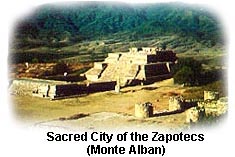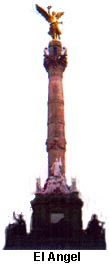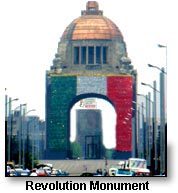Mexico's historical attractions - from the ancient ruins of the Olmecs, Maya, and Aztec, to the train routes used by the brash and legendary Pancho Villa - rank second only to the beaches of Cancun - and Alcapulco as the prime reason people come. The reason for this is simple: the tale of Mexico's past, accompanied by an overwhelming amount of physical remains, is as romantic, blood-curling, dramatic, and complex as it gets.
Somewhere around 1000 BC, the first of Mexico's ancient civilizations, the Olmecs, established themselves in what are now the states of Veracruz and Tabasco. They worshipped a jaguar God, built cities,
 constructed massive stone head carvings, and spread throughout central and southern Mexico until their civilization mysteriously vanished around 400 BC. Though the Olmecs left behind relatively few artifacts, their influence on later cultures was profound. In their wake came the Teotihuacan, the Zapotecs and Mixtecs of Monte Alban, the Maya of Yucatan, the Toltecs, Aztecs, and dozens of smaller, citied groups. To balance the spiritual and earthly realms and appease their pantheons of gods, many of these civilizations practiced human sacrifice, a fact that often overshadows their great achievements in the realms of mathematics, astronomy, architecture, textile weaving, art, and pottery. The Maya, for example, were so advanced in mathematics and astronomy that their calendar was the world's most accurate until this century. They could also predict solar and lunar eclipses.
constructed massive stone head carvings, and spread throughout central and southern Mexico until their civilization mysteriously vanished around 400 BC. Though the Olmecs left behind relatively few artifacts, their influence on later cultures was profound. In their wake came the Teotihuacan, the Zapotecs and Mixtecs of Monte Alban, the Maya of Yucatan, the Toltecs, Aztecs, and dozens of smaller, citied groups. To balance the spiritual and earthly realms and appease their pantheons of gods, many of these civilizations practiced human sacrifice, a fact that often overshadows their great achievements in the realms of mathematics, astronomy, architecture, textile weaving, art, and pottery. The Maya, for example, were so advanced in mathematics and astronomy that their calendar was the world's most accurate until this century. They could also predict solar and lunar eclipses.None of Mexico's pre-Columbian civilizations is more storied, however, than the Aztecs. Though it is arguable that other civilizations in Mexico achieved greater artistic and scientific feats, none advanced as quickly or ruled as much territory. Prior to the 15th century, the Aztecs were a marginal tribe living on the edge of Lake Texcoco, the site of present day Mexico City. By 1473, after subjugating neighboring tribes, they ruled the largest empire Mexico had ever seen. Their capital of Tenochtitlan, set in the lake, was a picturesque city of pyramids, mile-long floating roads, aquaducts, animated marketplaces, and one hundred thousand residents. Leading a highly codified government was an all-powerful emperor who exacted taxes from the conquered and distributed land to his people, especially the warriors. When the Spanish adventurer Hernan Cortez arrived in 1519, the rich city was a vision perfectly meshed to his thirst for conquest.
The Conquest of New Spain, a great and tragic history, begins in April of 1519 when a Cortes lands in Veracruz, about 200 miles from the Aztec capital. Cortes had a singular mission: defeat the Aztecs and take their gold. To do so, he had less than 400 soldiers, 16 horses, 14 pieces of artillery, 11 ships, plenty of guns and ammunition, and cajones. His first act upon landing was to burn all but one of his ships - he wanted no turning back. That he was able to defeat an empire with just a few hundred men seems nothing short of miraculous, but some of el conquistador's success, however, can be attributed to plain and simple luck.
According to an Aztec myth, the white-faced Quetzacuatl - their most important god - had long ago fled to the east, but would one day return. When the Aztec ruler, Moctezuma II, beheld Cortes and his light-skinned men upon their arrival in Tenochtitlan, he believed them to be emissaries of the great Quetzacuatl himself. The opportunistic Cortes, coached by Malinche - a Spanish-speaking Indian who had become his lover back at the coast - did not attempt to correct him. Cortes returned the emperor's hospitality by taking him hostage. A compliant Moctezuma ordered his people to stand down, and by the time the Aztecs began to resist Cortes had already brought in reinforcements from the coast. The Aztecs disowned their cooperative, captive emperor, who died a prisoner in his own palace. When the Aztecs finally laid siege to the palace, Cortes and his men snuck away in the middle of the night and ran for the coast. On the way, over half his force was killed by the pursuing army, but the survivors returned with thousands of Indian allies to conquer the city a year later.
Mexico, with its fertile plains and great mineral wealth, was the crown jewel of Spain's colonies. It was heavily taxed, ruled directly from Spain, and permitted no autonomy. The Spanish monarchs distributed land to settlers in the form of encomiendas (the predecessor to the
 hacienda), which were worked by Indian slaves that the settler's were charged to protect and convert to Christianity. A caste system developed: there were Espanoles (Spaniards born in Spain), criollos (Mexican-born, but with Spanish blood), mestizos (Spanish and Indian), and finally the indigenes, the Indians. Because of their forced dependence on the hacienda owners, and no resistance to European ailments, the Indians were riddled with debt and disease long after Spain abolished slavery in 1548.
hacienda), which were worked by Indian slaves that the settler's were charged to protect and convert to Christianity. A caste system developed: there were Espanoles (Spaniards born in Spain), criollos (Mexican-born, but with Spanish blood), mestizos (Spanish and Indian), and finally the indigenes, the Indians. Because of their forced dependence on the hacienda owners, and no resistance to European ailments, the Indians were riddled with debt and disease long after Spain abolished slavery in 1548.If the seeds of Mexican independence had not already been planted in the soil, then they were planted when Napoleon conquered Spain in 1808 When the French conqueror placed his brother on the Spanish throne, Mexico's elite began to talk of self-rule. The man who turned talk into action was a Catholic priest named Father Miguel de Hidalgo y Costilla, who led an armed rebellion in 1810. Though he was eventually captured and executed, Hidalgo's leadership began a war of independence that culminated on September 27, 1821, when the rebel leader Vicente Guerrero and the royalist Agustin de Iturbide signed the Treaty of Cordoba. Unfortunately, with independence Mexico's troubles were just beginning.
For almost a century, the new country would be wracked by marked by almost incessant fighting. One of the first Mexican presidents, the former rebel general Santa Ana, is sourly credited with losing half his country to the United States after a two-year war that ended in 1848. Santa Ana was eventually exiled and succeeded by Ignacio Comonfort, who abdicated the presidency in favor of one of Mexico's best-loved leaders, a mestizo from the state of Oaxaca ("Wah-ha-ka") named Benito Juarez.. Juarez liberalized the constitution and instituted
 land-reform, infuriating the wealthy conservative class and setting off a bloody conflict known as the War of Reform, which lasted from 1858 to 1861. Juarez's forces were victorious, but by the time the war was over Mexico's coffers were dry and it was defaulting on its foreign debt payments. France, a major lender, and saw this as a perfect excuse to invade. Napoleon III sent in the archduke of Austria, Maximilian, who quickly took most of the country. After a dogged resistance, Juarez finally retook Mexico City in 1867 and Maximilian was executed. To the archduke's credit, much of his defeat was caused by his own conscience and love for Mexico: during his rule, he passionately instituted a series of progressive reforms that enraged the conservatives and caused Napoleon to abandon him.
land-reform, infuriating the wealthy conservative class and setting off a bloody conflict known as the War of Reform, which lasted from 1858 to 1861. Juarez's forces were victorious, but by the time the war was over Mexico's coffers were dry and it was defaulting on its foreign debt payments. France, a major lender, and saw this as a perfect excuse to invade. Napoleon III sent in the archduke of Austria, Maximilian, who quickly took most of the country. After a dogged resistance, Juarez finally retook Mexico City in 1867 and Maximilian was executed. To the archduke's credit, much of his defeat was caused by his own conscience and love for Mexico: during his rule, he passionately instituted a series of progressive reforms that enraged the conservatives and caused Napoleon to abandon him.In 1871, a mestizo named Porfirio Diaz ran against Juarez for president and was defeated. A sore loser, he decided to overthrow the government and succeeded five years later. His iron-fisted rule, which lasted almost 40 years, became known as the Porfiriato. During his reign, Diaz sold off much of Mexico's industries to foreigners and routinely suppressed his opponents with brutal force. He was ultimately challenged by hacienda owner Francisco I. Madero in his famous book The Presidential Succession of 1910. Diaz ordered Madero arrested, but the latter fled to the US and returned to win the presidency in 1910, backed by the legendary Emiliano Zapata, who was leading a revolt against Diaz in the South. But Madero's presidency was short lived; Madero's own military commander, Victoriano Huerta, assassinated him with the help of the US embassador, and in the tremendously bloody war that ensued, Huerta's forces were pitted against a formidable alliance led by men whose names are now legend: Venustiano Carranza, General Alvaro Obregon, Emiliano Zapata, and the infamous Pancho Villa in the north. The Mexican Revolution, among the bloodiest internal conflicts in world history, was on.
Once Huerta was defeated, Carranza assumed the presidency, but this was only the beginning. Villa and Zapata, refusing to recognize him, drove he and Obregon from the capital. While the armies of the north and south held wild fiestas in the capital, Carranza and Obregon retreated to Veracruz, where they quickly reassembled and then retook the capital when Villa and Zapata failed to organize a government. Obregon later annihilated Villa's cavalry in Celaya, and Villa would never again be so powerful. Carranza held power until the next elections, when it became clear that the popular Obregon would defeat him. Falling into the now well-worn trap of wanting to hold power for too long, Carranza tried to stage a coup, but Obregon escaped and his forces returned to chase and kill Carranza as he fled along the old escape route to Veracruz. Meanwhile, in a last-ditch attempt to pull the United States into a conflict against Carranza, Villa invaded several US border towns and killed some inhabitants. After an unsuccessful pursuit by US forces, Villa finally hung up his pistoles and became a farmer in Parral. He was assassinated in 1923 when his car was ambushed. His brother in the south, Zapata, was also killed in 1919 after he was lured into a trap by a government soldier. When it was all over, the only man left alive, Obregon, was president.
Mexico's post-revolution history is marked by the tenacity of a single political party, the Partido Revolucionario Institutional, or PRI. The party was founded by Plutarco Elias Calles, who took over as president when Obregon was assassinated (quite possibly by a Calles plot) in 1928. But the party's most loved president was General Lazaro Cardenas in 1934. Cardenas instituted widespread land reform, strengthened unions, and nationalized the petroleum industry. PRI
 candidates, who are hand-picked by the president, have held power since - but not always peacefully. Election fraud has been endemic (although recent elections indicate this is changing). In 1968, the government violently suppressed a student protest in Mexico city, killing hundreds. The last 30 years have seen a heavily fluctuating economy, an influx of refugees from Central America, and inveterate government corruption (much of it linked to the illicit drug-trade). Though the North American Free Trade Agreement (NAFTA) has provided economic hope to some, it has also helped spur Indian guerillas in Chiapas to rebel against what they see as an uncaring government. Many Mexicans put their hope in 1994 PRI candidate Luis Donaldo Colosio, only to have them dashed when he was assassinated the same year in Tijuana. The current political atmosphere in Mexico is, however, optimistic. Indications are that the PRI is willing share power with the opposition. In 1997, for the first time in history, Mexico City elected a mayor who was not a PRI candidate. Traditionally, the mayoral seat of Mexico City is the second most powerful office in the nation, and the citizens of the Districto Federal could not have elected a more ironic man: he is Cuauhtemoc Cardenas, the son of the PRI's beloved Lazaro Cardenas. He ran against his father's party, and won
candidates, who are hand-picked by the president, have held power since - but not always peacefully. Election fraud has been endemic (although recent elections indicate this is changing). In 1968, the government violently suppressed a student protest in Mexico city, killing hundreds. The last 30 years have seen a heavily fluctuating economy, an influx of refugees from Central America, and inveterate government corruption (much of it linked to the illicit drug-trade). Though the North American Free Trade Agreement (NAFTA) has provided economic hope to some, it has also helped spur Indian guerillas in Chiapas to rebel against what they see as an uncaring government. Many Mexicans put their hope in 1994 PRI candidate Luis Donaldo Colosio, only to have them dashed when he was assassinated the same year in Tijuana. The current political atmosphere in Mexico is, however, optimistic. Indications are that the PRI is willing share power with the opposition. In 1997, for the first time in history, Mexico City elected a mayor who was not a PRI candidate. Traditionally, the mayoral seat of Mexico City is the second most powerful office in the nation, and the citizens of the Districto Federal could not have elected a more ironic man: he is Cuauhtemoc Cardenas, the son of the PRI's beloved Lazaro Cardenas. He ran against his father's party, and won

